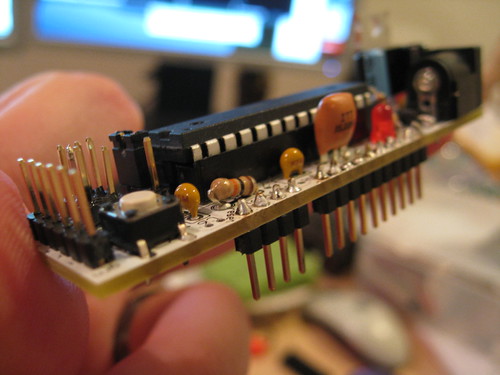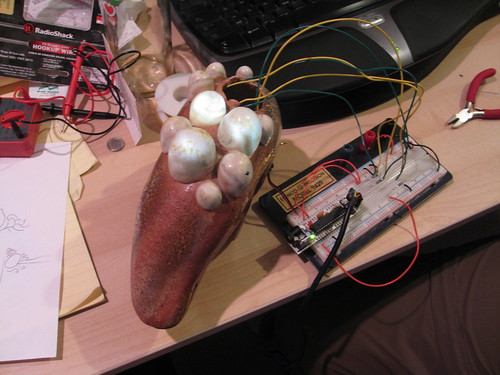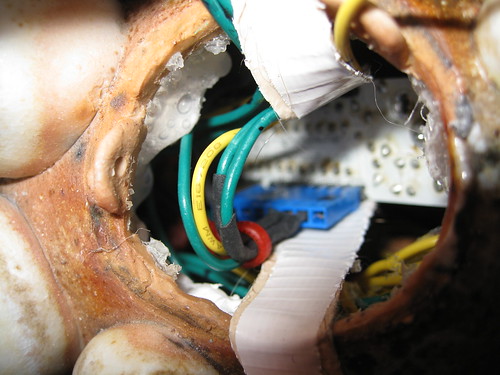Glowback - Arduino-powered glowing ceramic creature
While I spend most of my time in front of a keyboard and monitor, my partner Eva Funderburgh spends her time sculpting amazing, imaginary ceramic creatures. Her beasts are assembled out of different clays and wood-fired. About a year ago she enlisted my help in building a new type of beast with egg-shaped domes on its back. The idea was to have the domes glow and pulse with an organic, bioluminescent light. (Note: This was way before we’d seen Avatar!) Eva had already built and fired the beast a few months earlier, using thin shells of translucent Southern Ice porcelain for the domes. She left a few of the domes unattached so we could get lights inside after the firing.
We decided to use the open-source Arduino microcontroller platform to drive LEDs inside the domes - that way we could have a bunch of independently-controlled lights and set their behavior with software. We chose the Boarduino Arduino clone from Adafruit Industries because it’s cheap, easy to assemble, and much smaller than the full-size Arduinos. Soldering it together only took an hour or so.
After that we connected a total of 11 superbright LEDs (ordered from DigiKey) to the Boarduino. Since the Boarduino only has 6 PWM pins (which can be used to “fade” LEDs in and out), we put 5 really bright LEDs on their own PWM pins (for the big domes) and wired the remaining LEDs (slightly less blindingly bright ones) in parallel to the 6th pin. The LEDs are unbelievably bright - even after covering them in an anti-static bag they are tough to look at directly.
At this point we had to sketch up some software to actually control the lights. Eva wanted a random, organic pulsing, so I started by having each light animate through 360 degrees and used trigonometric functions to create a smooth curve of lighting and fading. We tried a whole bunch of different speeds, patterns, brightnesses, and randomization (some different tests: 1 2 3 4) before settling on the final code. The code is a bit messy because of all the things that got changed around. I ended up using 1 - abs(sin(θ)) as the main brightness function, which gave the lights a sort of “breathing” effect.

The 0-1 values from that function got converted into a brightness from 0-255 for the PWM output. Actually, the brightnesses were always between a set minimum and maximum brightness, so they never quite go all the way out. Each cycle the speed of the fade gets randomly modified, so the lights never line up in any pattern - it’s pretty hypnotic to stare at.
After this Eva had the unenviable task of stuffing the whole works into the beast. She built little foam stoppers for each LED, and pushed one up into each dome. Then she carefully crammed all the wires inside, and the Boarduino, a switch, and the 9V battery. It ended up being way too cramped, resulting in a lot of broken wires, resoldering, and hot glue burns. Lesson learned - the next glowing beast will be bigger, with more open access to the inside.
The end result is really captivating. Eva ended up displaying it at Gallery Madeira in Tacoma, WA along with some of her other creatures. Since we both put a lot of personal attention the two of us put into the Glowback, and the fact that due to all the hairy wiring inside it’s sort of “high maintenance”, we decided to keep it for ourselves instead of offering it for sale. However, Eva’s not done with the idea of lit beasts containing microcontrollers.
Eva’s has written up a post on the Glowback from her perspective on her own blog - I suggest checking it out to get more detail on the concept and lineage of the piece.



